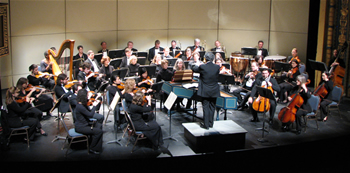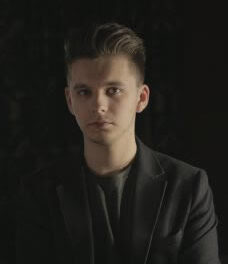A concert titled “The Titan and Sacred Music” was presented with a number of guest artists contributing to the pleasure and elucidation of the afternoon. The program began with Gabriel Fauré’s lyrical and haunting Pavane, op. 50. A slow courtly dance, it was first written for piano and then orchestrated for a modest orchestra of strings and woodwinds, including French horns. Today, guest conductor Michael Hamilton led the orchestra in a lush and elegant performance of Fauré’s work. Hamilton, the Chamber Orchestra of the Triangle Gala Live Auction Winner, called on his past experience in the Marine Band and Orchestra assigned to the White House. He is currently an active member of the COT Board of Directors.
Next on the program was Symphony No. 1 in C, Op. 21 by Ludwig van Beethoven for which the orchestra’s conductor and Artistic Director, Lorenzo Muti, took over the podium. With the first chords, the listener knows (looking backwards through what was to follow) that this is definitely the Beethoven, who in a few more years would put the world of classical music on a fast track to the romantic era with his Third and Fifth and later Symphonies, concertos, string quartets, solo piano pieces, and soaring choral masterpieces. Here in the First Symphony; his melodies are charming and fully developed in exemplary sonata form but one senses the young (he was 30 years old at the premier in 1800) Beethoven’s need to stretch and expand the sonata form that Haydn had passed on to him, and Mozart had touched with his magic brush. His deployment of the woodwinds is innovative. His frequent use of sforzandi is typical of Beethoven. Here and there some of the darkness and serious explorations of the human experience are hinted. Muti’s command of the orchestra throughout this performance was characterized by a careful and, if I may say so, reverent reading. Likewise the orchestra was consistently precise in attacks, cut-offs and meaningful phrasing. It was an affirmation that young Beethoven had something to say and the First Symphony is worth hearing for its own pleasures.
The second half of the concert was given over to a rare performance of Beethoven’s 1807 Mass in C, Op. 86. For this performance, COT was joined by the Concert Singers of Cary, since 1991 under the leadership of co-founder, conductor and Artistic Director, Lawrence Speakman. As a volunteer community chorus they have consistently demonstrated artistic achievement and growth. Their solid support throughout the community is demonstrated in the generous funding they provided for this concert. The outstanding soloists were the cream of the Triangle area’s best: soprano Patricia Philipps, mezzo soprano Ginger Jones, tenor Wade Henderson and bass Don Milholin.
With the ascension of Nikolaus II, Haydn performed largely ceremonial duties for the Esterhazys, principally consisting of composing an annual mass for the name day of the Prince’s wife (and Haydn’s friend), Princess Maria Josepha Hermenegild. The aging Haydn continued to perform this annual service until his health failed in 1802. In 1807, the commission for the name day mass went to Beethoven. It was his first foray into mass composition and he was awed at the prospect of following in his former teacher’s footsteps. Having procrastinated, Beethoven completed the mass just in time to begin rehearsals for the slated performance.
To put it mildly, rehearsals did not go well and from all reports the premier was a disaster. The prince is reputed to have said, “But my dear Beethoven, what is this you have done now?” at which Hummel (the chorus master) snickered and Beethoven left the house in a rage.
The Mass was heard by a wider public just over a year later when it was more successfully received. Still it took several years of negotiations before Beethoven was able to get the mass published. The unfortunate beginning may account for its under-performance over the years, which is regrettable, because the Mass is decidedly an inspired and magnificently crafted work, combining classical formal elements with romantic expressiveness. The solo parts do not stand alone, but are integrated with the choir throughout. The writing employs progressive orchestration, bold harmonic and rhythmic language, and striking textual tone painting. Typically, Beethoven uses the inherited formal classical models and infuses them with a revolutionary, romantic, deeply affective musical content. Perhaps it was just more than Prince Esterházy could grasp.
This performance was a moving revelation of the sensitivity and power of this gem of creativity. Speakman had the chorus well prepared and they sang marvelously. Balance, diction, intonation were all impeccable. The soloists each stood out in their respective artistry and interplay with the chorus. From the opening of the Kyrie, which begins with the basses of the choir unaccompanied who are then are joined by the rest of the choir, the blend of vocal and instrumental elements enhanced the wondrous lyrical, almost mystical, quality of the mass.
The Agnus Dei concludes with a reprise of the opening Kyrie theme, in which the text “dona nobis pacem” receives its last sublime utterance. The work ends with a hushed, contemplative prayer for peace.












